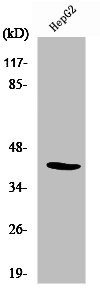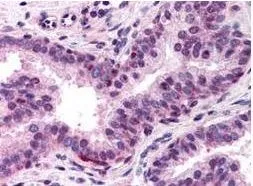NFYA antibody
GTX109511
ApplicationsImmunoFluorescence, Western Blot, ImmunoCytoChemistry, ImmunoHistoChemistry, ImmunoHistoChemistry Paraffin
Product group Antibodies
TargetNFYA
Overview
- SupplierGeneTex
- Product NameNFYA antibody
- Delivery Days Customer9
- Application Supplier NoteWB: 1:500-1:3000. ICC/IF: 1:100-1:1000. IHC-P: 1:100-1:1000. *Optimal dilutions/concentrations should be determined by the researcher.Not tested in other applications.
- ApplicationsImmunoFluorescence, Western Blot, ImmunoCytoChemistry, ImmunoHistoChemistry, ImmunoHistoChemistry Paraffin
- CertificationResearch Use Only
- ClonalityPolyclonal
- Concentration0.19 mg/ml
- ConjugateUnconjugated
- Gene ID4800
- Target nameNFYA
- Target descriptionnuclear transcription factor Y subunit alpha
- Target synonymsCBF-A, CBF-B, HAP2, NF-YA, nuclear transcription factor Y subunit alpha, CAAT-box DNA binding protein subunit A, CCAAT-binding transcription factor subunit B, HAP2 CCAAT-binding protein, NFYA transcript, Transcription factor NF-Y, A subunit, nuclear transcription factor Y subunit A, nuclear transcription factor Y, alpha
- HostRabbit
- IsotypeIgG
- Protein IDP23511
- Protein NameNuclear transcription factor Y subunit alpha
- Scientific DescriptionThe protein encoded by this gene is one subunit of a trimeric complex, forming a highly conserved transcription factor that binds to CCAAT motifs in the promoter regions in a variety of genes. Subunit A associates with a tight dimer composed of the B and C subunits, resulting in a trimer that binds to DNA with high specificity and affinity. The sequence specific interactions of the complex are made by the A subunit, suggesting a role as the regulatory subunit. In addition, there is evidence of post-transcriptional regulation in this gene product, either by protein degradation or control of translation. Further regulation is represented by alternative splicing in the glutamine-rich activation domain, with clear tissue-specific preferences for the two isoforms. [provided by RefSeq]
- Storage Instruction-20°C or -80°C,2°C to 8°C
- UNSPSC12352203


![Western Blot of Rabbit Anti-NF-Y(A subunit) Antibody. Lane 1: CHO-7 cells in the absence (I) of cholesterol. Lane 2: CHO-7 cells in the presence (S) of cholesterol. Load: Equivalent aliquots of chromatin from each sample containing ~50 microg of total protein per lane. Primary antibody: anti-NF-YA antibody at 1:1000 for overnight at 4oC. Secondary antibody: HRP conjugated Goat-anti-Rabbit IgG [H&L] secondary antibody at 1:10,000 for 45 min at RT. Predicted/Observed size: doublet of ~ 42 kDa for NF-Y A.](https://www.genetex.com/upload/website/prouct_img/normal/GTX26558/GTX26558_20160330_WB_w_23060722_181.webp)



